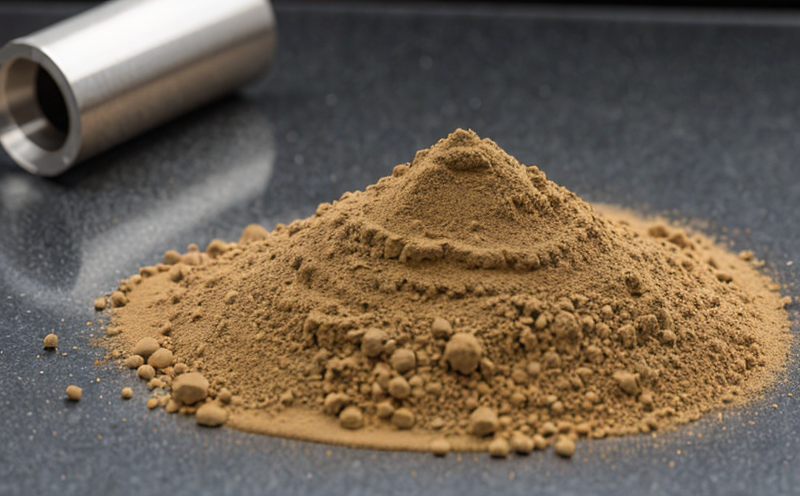ASTM D6393 Flowability Testing of Powders
The ASTM D6393 flowability testing method evaluates the ability of powder materials to pass through narrow openings under controlled conditions. This is essential for additive manufacturing (AM) and 3D printing processes where particle size distribution, shape, and surface area all influence processing efficiency and final product quality.
The primary goal of ASTM D6393 testing is to provide a quantitative measure of the powder's resistance to flow through a sieve. This helps manufacturers optimize the process parameters for additive manufacturing and ensures that raw materials meet the required specifications for consistent performance in production environments.
To perform this test, a known quantity of powder is poured into a funnel with a constricted orifice. The time taken for the powder to pass completely through the funnel is measured. This duration provides insight into the flowability characteristics of the material. A faster passage indicates better flowability, which is desirable in AM processes where quick and uniform deposition are critical.
Proper specimen preparation involves sieving the powder sample according to ASTM D6393 specifications to ensure that it represents a consistent particle size distribution. This step ensures accurate measurement of flow characteristics without bias from oversized or undersized particles.
The test apparatus typically includes funnels with standardized orifices, timers for measuring passage time, and sieves for preparing the sample. Compliance with ASTM D6393 standards is crucial to ensure reliable and comparable results across different laboratories.
Flowability testing is particularly important in AM processes involving laser powder bed fusion (LPBF) and electron beam melting (EBM), where poor flow characteristics can lead to inconsistent layer thicknesses, reduced build speeds, or even process failures. By optimizing powder flowability through ASTM D6393 tests, manufacturers can enhance the overall quality of their 3D printed parts.
Real-world applications demonstrate that consistent and repeatable results from ASTM D6393 testing are vital for quality assurance in AM processes. For instance, a manufacturer might use this data to identify optimal powder types or processing parameters for specific part geometries. Proper flowability ensures that the powder flows smoothly into the build chamber, leading to more reliable and higher-quality parts.
Understanding the nuances of ASTM D6393 testing can also help in troubleshooting process issues. For example, if a particular batch of powder consistently fails to meet flowability criteria, it may indicate an issue with particle size distribution or surface conditioning that needs addressing before proceeding with AM processes.
Scope and Methodology
The scope of ASTM D6393 testing is focused on characterizing the flowability properties of powders, which are critical in additive manufacturing and 3D printing. The test evaluates how easily a powder can pass through a constricted orifice under gravity.
- Funnel with a standard orifice size
- Precision timer to measure passage time
- Sieving of the sample according to ASTM D6393 guidelines
The methodology involves carefully preparing the powder by sieving it through appropriate screens. The sieved material is then poured into a funnel with a known orifice size, and the time taken for all particles to pass completely through the funnel is recorded.
This test provides valuable insights into the flow characteristics of powders used in AM processes. It helps determine whether the powder will behave predictably under the conditions encountered during manufacturing. Poor flowability can lead to issues such as clogging, uneven layer deposition, and reduced build speeds.
ASTM D6393 ensures that all parties involved in additive manufacturing have a standardized approach to evaluating powder flowability. This standardization is crucial for maintaining consistent quality across different production environments and facilities.
Benefits
The benefits of ASTM D6393 flowability testing are numerous, particularly in the context of additive manufacturing (AM) and 3D printing. By ensuring that powders meet specific flowability criteria, this test enables manufacturers to optimize their processes for better performance and product quality.
Firstly, ASTMD6393 helps identify optimal powder characteristics early in the development stage. This allows engineers to select materials that will perform consistently across various AM processes. Secondly, it aids in troubleshooting by highlighting potential issues with particle size distribution or surface conditioning.
Incorporating ASTM D6393 into quality assurance protocols ensures that every batch of raw material is tested for flowability before being used in production. This minimizes the risk of process failures due to poor powder characteristics, leading to more reliable and higher-quality parts.
Additionally, compliance with this standard enhances confidence among stakeholders such as quality managers, procurement officers, and R&D engineers, who rely on consistent data from ASTM D6393 tests when making decisions about material selection and process optimization.
The use of standardized testing methods like ASTM D6393 also facilitates international collaboration by providing a common benchmark for evaluating powder flowability. This is especially important in the rapidly evolving field of AM, where global standards are essential for seamless integration between different manufacturing facilities and supply chains.
International Acceptance and Recognition
- ISO/ASTM 57198: International standardization effort that aligns ASTM D6393 with global practices in powder flowability testing.
- EN ISO 14670-1: European equivalent, which includes the flowability test as part of a broader suite of standards for powder handling and processing.
- IEC TS 62893: Technical specification for additive manufacturing processes that references ASTM D6393 in its guidelines on raw material characterization.
The ASTM D6393 flowability testing method has gained widespread acceptance not only within the United States but also internationally. Its adoption by numerous countries underscores its relevance and reliability across diverse industrial sectors, including aerospace, automotive, medical devices, and consumer electronics.
Many leading organizations worldwide have incorporated ASTM D6393 into their quality management systems to ensure consistent powder flowability in additive manufacturing processes. By aligning with international standards such as ISO/ASTM 57198, EN ISO 14670-1, and IEC TS 62893, these organizations demonstrate their commitment to excellence and regulatory compliance.
The growing recognition of ASTM D6393 reflects its importance in ensuring high-quality additive manufacturing outputs. As the demand for precision in AM continues to rise, adherence to this standard becomes increasingly critical for maintaining competitive advantage and meeting stringent industry standards.





